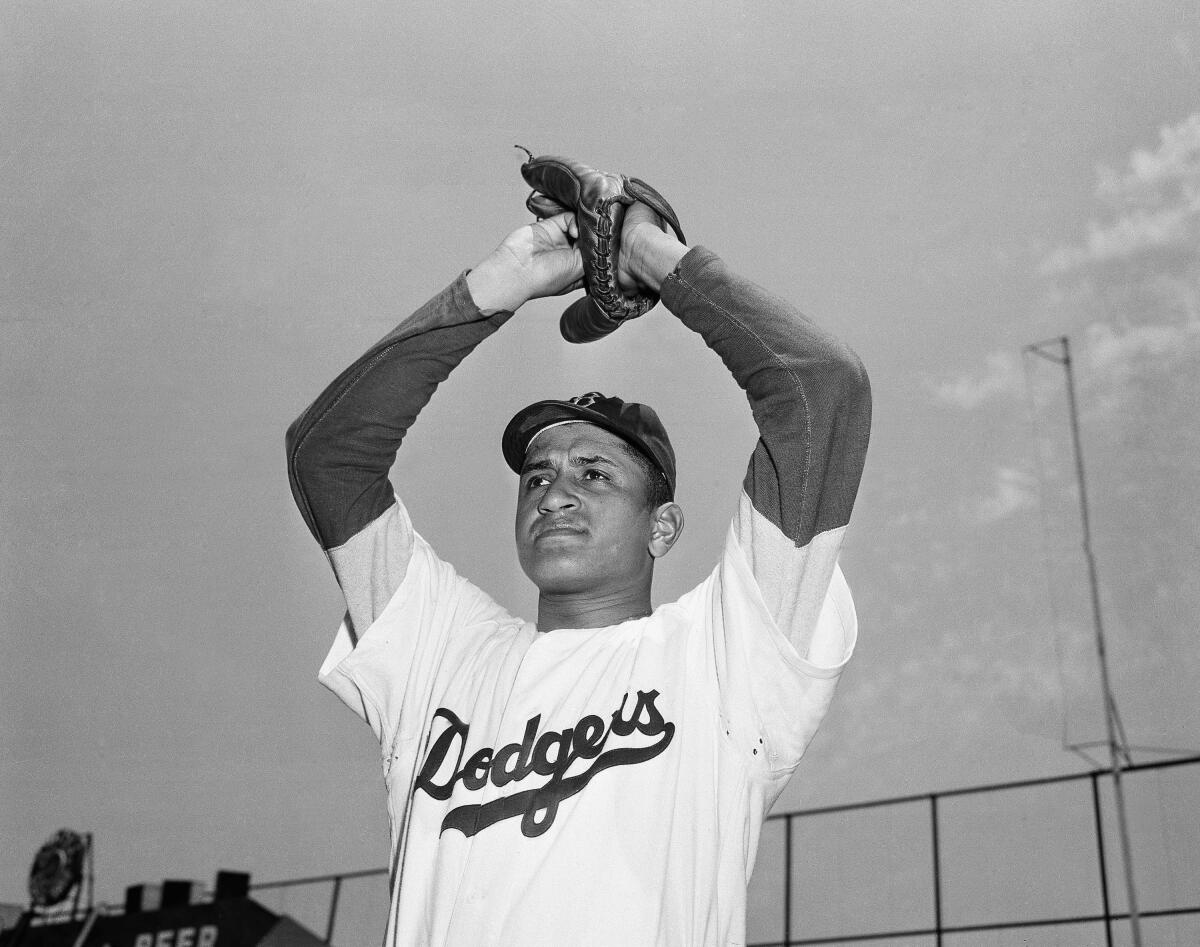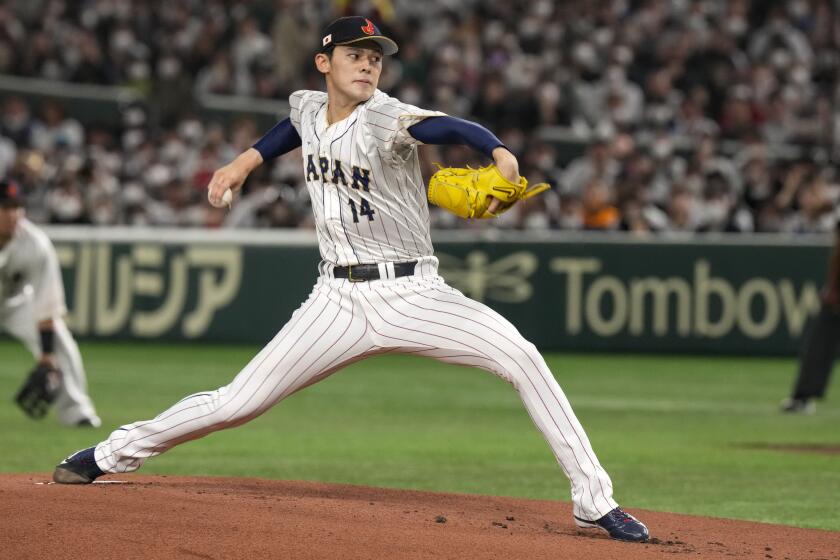Dodgers Dugout: The 25 greatest Dodgers of all time, No. 21: Don Newcombe

Hi, and welcome to another edition of Dodgers Dugout. My name is Houston Mitchell as we continue the top 25 countdown, with a big correction after that.
Are you a true-blue fan?
Get our Dodgers Dugout newsletter for insights, news and much more.
You may occasionally receive promotional content from the Los Angeles Times.
Readers voted in droves, submitting 15,212 ballots by email, Twitter and Facebook. Voters were asked for their top 10 Dodgers in order from 1 to 10, with first place receiving 12 points, second place nine points, third place eight, all the way down to one point for 10th place.
The last time we did this was in 2018, and there were some changes in the rankings.
So, without further ado:
Enjoying this newsletter?
Your support helps us deliver the news that matters most. Become a Los Angeles Times subscriber.
The 25 greatest Dodgers, No. 21: DON NEWCOMBE (4,778 points)
2018 rank: 21st
Shohei Ohtani? Don Newcombe could have been a two-way player if the Dodgers would have let him.
In 1956, Newcombe went 27-7 with a 3.06 ERA in 38 games, 36 starts and 268 innings with 15 complete games. At the plate, he hit .234 with six doubles, two homers and 16 RBIs. He won the Cy Young and MVP awards after the season. He was Rookie of the Year in 1949 and is the first player to win all three major baseball awards.
In an eight-season Dodgers career, Newcombe went 123-66 with a 3.51 ERA. He went 20-5 during the Dodgers’ World Series champion 1955 season. That year, he hit .259 with nine doubles, seven homers and 23 RBIs. How good a hitter was Newcombe? He pinch-hit 88 times in his career.
He last pitched in the majors with Cleveland in 1960. In 1962, he signed with the Chunichi Dragons in Japan, as a hitter, not as a pitcher. In 81 games, he hit .262 with 12 home runs and 43 RBIs.
Newcombe was born in Madison, N.J. on June 14, 1926. His father, Roland, made home-brewed beer, and allowed Don to start drinking it when he was 8, which likely led to his eventual alcoholism.
My favorite Newcombe story: Pearl Harbor was attacked when Newcombe was 15. He was over 6 feet tall and weighed about 220, so he figured if he lied about his birthdate he could enlist in the military. The Army recruiter caught on pretty quickly that he was only 15 and called Newcombe’s father to pick him up.
Newcombe’s high school did not have a baseball team, so he played semi-pro baseball and caught the eye of the Newark Eagles of the Negro National League. He dropped out of high school in his junior year in 1943 to play for the Eagles. His father was disappointed, wanting Newcombe to become a boxer, but as recounted in Peter Golenbock‘s “Bums: An Oral History of the Brooklyn Dodgers,” Roland Newcombe said “Don told me he didn’t want to fight because he didn’t want to get his face punched,”
In late 1945, Newcombe was named to a Negro Leagues all-star team that played a group of white major leaguers at Ebbets Field, home of the Brooklyn Dodgers. His catcher for that game was Roy Campanella. Branch Rickey of the Dodgers watched the game and liked and signed both of them,sending them to the Nashua Dodgers of the New England league after the president of the Three-I league threatened to fold the league entirely if Rickey tried to integrate the Danville Dodgers.
Newcombe threw a shutout in his first start with the Nashua Dodgers. He also became the driver of the team bus.
Before the 1947 season, Rickey had decided it was time to bring Jackie Robinson to the majors. He moved the Dodgers’ spring training site from Florida, with its oppressive racial laws, to Cuba.
However, even in Cuba, Rickey kept his four Black players (Robinson, Newcombe, Campanella and Roy Partlow) at a different hotel than the white players. The conditions of the hotel were deplorable, something Robinson talked about for years afterward. Newcombe had an experience there he never forgot: “One night I sat in the restaurant next to the hotel eating a bowl of soup. I stirred the soup and a cockroach came up out of it. I threw up everything I had in me all over the counter.”
Newcombe returned to the minors in 1947 and 1948, watching as Robinson and then Campanella became stars with the Dodgers. He finally made the majors in 1949, and after a poor relief appearance, threw a shutout in his first start.
He remained a stalwart for the Dodgers, but drank a lot. Two years after his standout 1956 season, he was 0-6 with a 7.86 ERA in the Dodgers’ first year in L.A. and was still drinking heavily. The Dodgers traded him to Cincinnati on June 15 for first baseman Steve Bilko and pitchers Johnny Klippstein, Art Fowler and Charlie Rabe.
Newcombe was out of the majors after a poor 1960 season. He played one season in the minors and then one in Japan. He declared bankruptcy in 1965. He pawned his 1955 World Series ring to get money to buy some alcohol (years later, the Dodgers purchased the ring in an auction and returned it to Newcombe).
In 1966, his wife, Billie, said if he didn’t stop drinking she would take their son, then 4, and leave and he would never see them again. That was the day, Newcombe said, that he quit drinking and never drank again.
Newcombe devoted his life after that to helping others who were struggling with alcohol abuse. He created the Dodger Drug and Alcoholic Awareness Program in 1980 and became a consultant for the National Institute on Alcohol Abuse and Alcoholism. He died in 2019 at the age of 92.
“What I have done after my baseball career and being able to help people with their lives and getting their lives back on track and they become human beings again means more to me than all the things I did in baseball,” Newcombe said in 2008.
Should Don Newcombe be in the Hall of Fame? If you go strictly by the numbers, no. But if you consider he missed part of his career because of the ban against Black players, and part of his career because he served two years in Korea during the Korean War, and you consider all the baseball players he helped since retirement, then a strong case can be made for Newcombe.
Previously
Whoops!
In Thursday’s newsletter, I wrote that the No. 1 seed plays the winner of the No. 3 vs. No. 6 first-round series and the No. 2 seed plays the No. 4 vs. No. 5 winner. It’s actually the other way around, The sad thing is I knew this when I wrote it, but my hands typed something else. Or, I was testing everyone to see if they were paying attention. Yeah, that’s what I’ll go with. My apologies to everyone. So, to recap:
The No. 1 seed plays the winner of No. 4 vs. No. 5, the No. 2 seed plays the winner of No. 3 vs. No. 6. The reason? MLB wants the teams with the best record to not have to play a division winner until the NLCS. There will be a quiz later.
Dodgers-Braves update
If Thursday’s game was any indication, this is going to be a great weekend series against the Braves.
And finally
Don Newcombe talks about his career. Watch and listen here.
Until next time...
Have a comment or something you’d like to see in a future Dodgers newsletter? Email me at [email protected], and follow me on Twitter at @latimeshouston. To get this newsletter in your inbox, click here.
Are you a true-blue fan?
Get our Dodgers Dugout newsletter for insights, news and much more.
You may occasionally receive promotional content from the Los Angeles Times.




